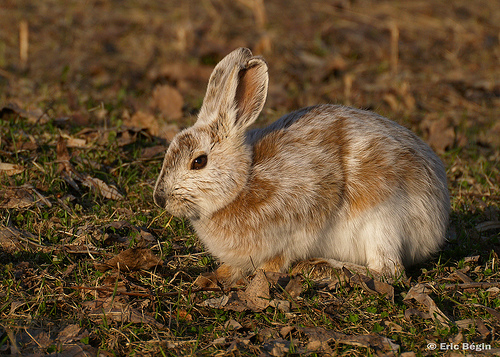I was looking through the National Geographic website for a glimmer of information on an interesting animal to write about for this assignment, when an adorable, classic picture of a white rabbit caught my eye:

Snowshoe Hare: Lepus Americanus. Photograph taken by Michael S. Quinton for the National Geographic Society
Definitely a far cry from the image that popped in my mind of the White Rabbit in Tim Burton’s recent movie! :

Rabbits have been such a well-liked creature to be embedded in stories within entertainment and popular culture (think Peter Rabbit, Roger Rabbit, Bugs Bunny...)
By the way, ‘rabbit’ would be the widely misused term many might have in labelling the animal you see above. These white mammals are actually ‘hares’ (yes there are differences!) – one might be compelled to use them interchangeably, but technically both do differ in terms of size, appearance of offspring, ear length etc…
So the furry little creature you see in the first picture is known as the Snowshoe Hare (scientific name: Lepus Americanus), because of the size and shape of its hind feet which helps them stay atop thick patches of snow (this species being found particularly in many parts of the North American continent – USA and Canada – along elevated lands and even shores of the Arctic Ocean, though they can be seen down south such as around New Mexico)
They are also known as the Varying Hare – why? One of the reasons is due to its ability to change its fur colour according to the season! Towards fall and in winter the Snowshoe Hare has a white coat of fur, whereas towards summer it gradually changes to brown as that of this hare below:
Though carried out a long while back, a study done by Grange (1932) (my second source for this blog post) emphasises this adaptive behaviour of the snowshoe hare ” in avoiding intruders” (coupled with their sensitive ears and quick active legs in escaping predation) (Grange 1932, 101). The seasonal molts as in the shedding of white fur could be triggered by changes in amount of daylight or temperature that induces a hormonal reaction and cause changes in coat. This helps the Snowshoe hare camouflage within its environment from the many predators it has (lynx, coyotes, owls, hawks…). A couple of interesting tidbits, as according to Grange:
– the changes in fur are not correlated directly to immediate climatic conditions, but significantly to average climatic conditions (i.e. there are cases whereby even in absence of snow, the fur changes from brown to white)
– colour change is observed to be coming from growth of hair of new colour, with growth of new fur for winter being “longer, heavier and thicker” (Grange 1932, 115); this difference in fur strand structure counters the notion of a direct change of the colour of the hair itself (instead of replacement) – there is observance that though some hairs are say, uniformly white, most of the fur strands are banded in diffused colours from root to tip.
Practical, and fashionable at the same time, no?
References:
British Columbia (2003) Wildlife and Nature – Snowshoe Hare. Accessed 9 April 2010 from http://www.britishcolumbia.com/WildLife/wildlife/landmammals/cw/cw_snowshoehare.html
Fraley, J. (2006) Montana Outdoor Portraits: Snowshoe Hare. Accessed 9 April 2010 from http://fwp.mt.gov/mtoutdoors/HTML/articles/portraits/snowshoe.htm
Grange, W.B. (1932) The Pelages and Color changes of the Snowshoe Hare, Lepus Americanus Phaeonotus, Allen. Journal of Mammology, 13(2), pp. 99 – 116
Harris, T. (2010) How Animal Camouflage works. Accessed 9 April 2010 from http://animals.howstuffworks.com/animal-facts/animal-camouflage2.htm
Keith, L.B. (2010) Hinterland’s Who’s Who – Mammal Fact Sheet: Snowshoe Hare. Accessed 9 April 2010 from http://www.hww.ca/hww2.asp?id=103 [online]
The National Geographic Society (2010) Snowshoe Hare: Lepus Americanus. Accessed 9 April 2010 from http://animals.nationalgeographic.com/animals/mammals/snowshoe-hare/
Wikipedia (2010) Snowshoe Hare. Accessed 9 April 2010 from http://en.wikipedia.org/wiki/Snowshoe_Hare
Pictures Used:
Alice in Wonderland 2010 poster Alice and the Rabbit. Uploaded on February 22 2010 by christopher_aquino at Flicker.com. Accessed 9 April 2010 from http://www.flickr.com/photos/cmaotaku/4378727576/
Snowshoe Hare: Lepus Americanus. Photograph taken by Michael S. Quinton for the National Geographic Society. Accessed 9 April 2010 from http://animals.nationalgeographic.com/animals/mammals/snowshoe-hare/
Snowshoe Hare / Lièvre d’Amérique. Uploaded on April 19, 2008 by Eric Bégin at Flickr.com. Accessed 9 April 2010 from http://www.flickr.com/photos/ericbegin/2426073031/

